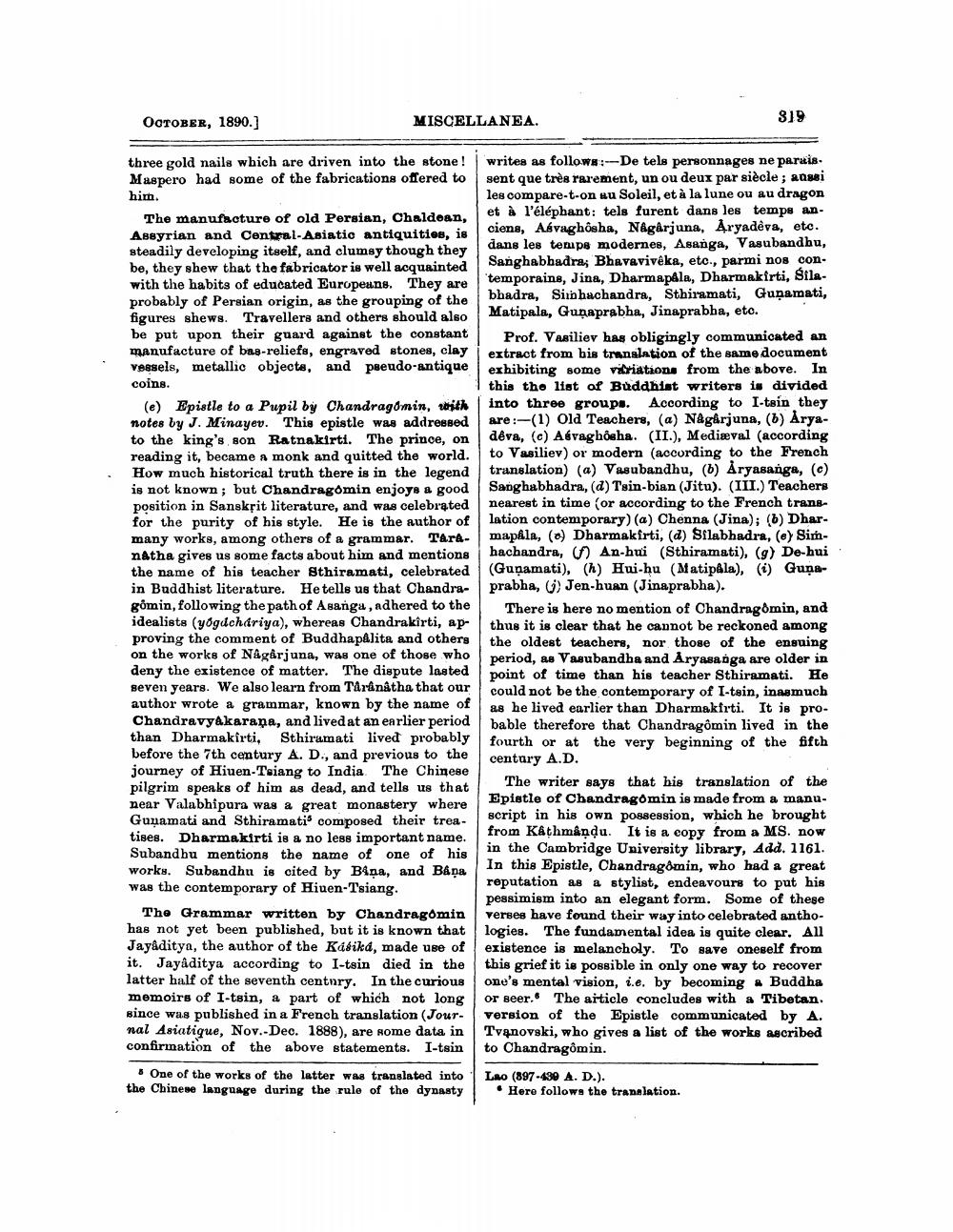________________
OCTOBER, 1890.]
MISCELLANEA.
319
him.
three gold nails which are driven into the stone! writes as follows:--De tels personnages ne parais. Maspero had some of the fabrications offered to sent que très rarement, un ou deux par siècle ; aussi
les compare-t-on uu Soleil, et à la lune ou au dragon The manufacture of old Persian, Chaldean,
et à l'éléphant: tels furent dans les temps anAssyrian and Central Asiatic antiquities, is
ciens, Asvaghôsha, Nagarjuna, Aryadeva, etc. steadily developing itself, and clumsy though they
dans les temps modernes, Asanga, Vasubandhu, be, they shew that the fabricator is well acquainted
Sanghabhadra; Bhavavivêka, eto, parmi nos conwith the habits of educated Europeans. They are
temporains, Jina, Dharmapala, Dharmakirti, Sila. probably of Persian origin, as the grouping of the
bhadra, Sinhachandra, Sthiramati, Gunamati, figures shews. Travellers and others should also
Matipala, Guņaprabha, Jinaprabha, etc. be put upon their guard against the constant Prof. Vasiliev has obligingly communicated an manufacture of bas-reliefs, engraved stones, clay | extract from bis translation of the same document vessels, metallic objects, and pseudo-antique exhibiting some variations from the above. In coins.
1 this the list of Buddhist writers is divided (e) Epistle to a Pupil by Chandragomin, with into three groups. According to I-tsin they notes by J. Minayev. This epistle was addressed are:-(1) Old Teachers, (a) Nagarjuna, (b) Aryato the king's son Ratnakirti. The prince, on déva, (c) Asvaghôsha. (II.), Mediæval (according reading it, became a monk and quitted the world. to Vasiliev) or modern (according to the French How much historical truth there is in the legend translation) (a) Vasubandhu, (b) Aryasanga, (c) is not known; but Chandragomin enjoys a good Sanghabhadra, (a) Tsin-bian (Jitu). (III.) Teachers position in Sanskrit literature, and was celebrated nearest in time (or according to the French transfor the purity of his style. He is the author of lation contemporary) (a) Chenna (Jina); (b) Dhar. many works, among others of a grammar. Tark- mapala, (a) Dharmakirti, (d) Silabhadra, (o) Simnatha gives us some facts about him and mentions hachandra, An-hui (Sthiramati), (q) De-hui the name of his teacher Sthiramati, celebrated (Gunamati), (h) Hui.hu (Matipala), (i) Gunain Buddhist literature. He tells us that Chandra- prabha, () Jen-huan (Jinaprabha). gömin, following the path of Asanga , adhered to the
There is here no mention of Chandragomin, and idealists (yogdchdriya), whereas Chandrakirti, ap- thus it is clear that he cannot be reckoned among proving the comment of Buddhapalita and others the oldest teachers, nor those of the ensuing on the works of Nagarjuna, was one of those who period, as Vagubandha and Aryasanga are older in deny the existence of matter. The dispute lasted
point of time than his teacher Sthiramati. He seven years. We also learn from Taranatha that our could not be the contemporary of I-tsin, inasmuch author wrote a grammar, known by the name of
as he lived earlier than Dharmakirti. It is proChandravyakarana, and lived at an earlier period
bable therefore that Chandragômin lived in the than Dharmakirti, Sthiramati lived probably
fourth or at the very beginning of the fifth before the 7th century A. D., and previous to the
centary A.D. journey of Hiuen-Teiang to India The Chinese pilgrim speaks of him as dead, and tells us that
The writer says that his translation of the near Valabhipura was a great monastery where
Epistle of Chandragomin is made from a manuGunamati and Sthiramatis composed their trea
script in his own possession, which he brought tises. Dharmakirti is a no less important name.
from Kathmandu. It is a copy from a MS. now Subandhu mentions the name of one of his
in the Cambridge University library, Add. 1161. works. Subandhu is cited by B4ņa, and Bana
In this Epistle, Chandragomin, who had a great was the contemporary of Hiuen-Tsiang.
reputation as a stylist, endeavours to put his
pessimism into an elegant form. Some of these The Grammar written by Chandragomin verses have found their way into celebrated anthohas not yet been published, but it is known that logies. The fundamental idea is quite clear. All Jayaditya, the author of the Katika, made use of existence is melancholy. To save oneself from it. Jayaditya according to I-tsin died in the this grief it is possible in only one way to recover latter half of the seventh century. In the curious one's mental vision, i.e. by becoming # Buddha memoirs of I-tsin, a part of which not long | or seer. The article concludes with a Tibetan. since was published in a French translation (Jour- version of the Epistle communicated by A. nal Asiatique, Nov.-Dec. 1888), are some data in Tvanovski, who gives a list of the works ascribed confirmation of the above statements. I-tsin to Chandragômin.
. One of the works of the latter was translated into the Chinese language during the rule of the dynasty
Lao (897-430 A. D.).
Here follows the translation.




